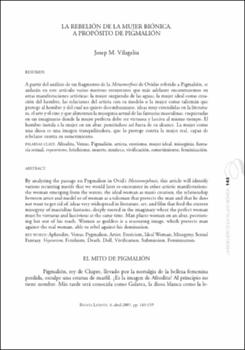La rebelión de la mujer biónica. A propósito de Pigmalión
Autor
Vilageliu, Josep M.Fecha
2005Resumen
A partir del análisis de un fragmento de la Metamorfosis de Ovidio referido a Pigmalión, se
aislarán en este artículo varios motivos recurrentes que más adelante encontraremos en
otras manifestaciones artísticas: la mujer surgiendo de las aguas, la mujer ideal como creación
del hombre, las relaciones del artista con su modelo o la mujer como talismán que
protege al hombre y del cual no quiere desembarazarse, ideas muy extendidas en la literatura,
el arte y el cine y que alimentan la misoginia actual de las fantasías masculinas, enquistadas
en un imaginario donde la mujer perfecta debe ser virtuosa y lasciva al mismo tiempo. El
hombre instala a la mujer en un altar, poniéndose así fuera de su alcance. La mujer como
una diosa es una imagen tranquilizadora, que lo protege contra la mujer real, capaz de
rebelarse contra su sometimiento. By analyzing the passage on Pygmalion in Ovid’s Metamorphosis, this article will identify
various recurring motifs that we would later re-encounter in other artistic manifestations:
the woman emerging from the waters, the ideal woman as man’s creation, the relationship
between artist and model or of woman as a talisman that protects the man and that he does
not want to get rid of, ideas very widespread in literature, art, and film that feed the current
misogyny of masculine fantasies, deeply rooted in the imaginary where the perfect woman
must be virtuous and lascivious at the same time. Man places woman on an altar, positioning
her out of his reach. Woman as goddess is a reassuring image, which protects man
against the real woman, able to rebel against his domination.





